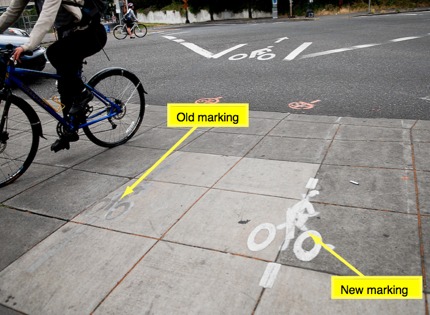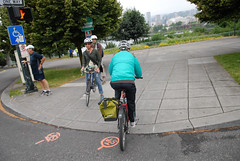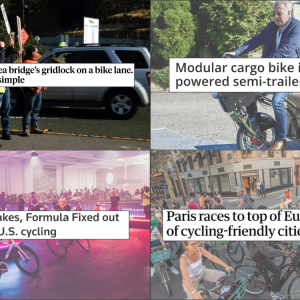
(Photos © J. Maus)
When I wrote a story about a series of annoyingly jarring, and sometimes injury-causing bumps on the Eastbank Esplanade ramps earlier this month, many people felt it was just unecessary whining. “We have much more important issues to deal with!”, “This is why people think cyclists have such a bad reputation of entitlement!”, “Stop whining and just deal with it!” were common sentiments expressed in the comments.
The Portland Parks bureau heard about the issue and, while the bumps will remain for now, they are looking into improved signage to warn of the bumps’ presence and make them more visible to people on bikes.
Given the tone of feedback and comments I received after reporting on that issue, I was quite interested to notice that the Portland Bureau of Transportation recently addressed a similar issue just a bit north of the Esplanade ramps. I think it makes for an interesting comparison.
“It was awkward, a little bit of a nuisance, and this is one really inexpensive thing that might make it better.”
— Jeff Smith, PBOT
A few weeks ago, crews shifted the location of a bike signal sensor loop marking (see photo at top of story). The problem (which was well-known to people who use that route regularly) is that people headed north would wait for the light over the old pavement marking. Unfortunately, the marking was smack dab in the middle of the curb ramp where bike traffic coming in the opposite direction needed to go. This caused a bit of a snafu because there wasn’t much room to pass.
Even though there were no reports of injuries or collisions and there are certainly more pressing issues to address in our bikeway network, this seemingly minor annoyance somehow merited attention and a fix by PBOT. The marking has been moved a few feet to the right (don’t worry, it still triggers the signal).
Jeff Smith, the PBOT staffer who managed the project, said they’d heard about the issue from several sources before deciding to move the marking. “It [the location of the marking] was awkward… a little bit of a nuisance, and this is one really inexpensive thing that might make it better.”
Making these types of refinements may seem trivial, but when small annoyances accumulate, they can have a negative impact on someone’s decision to consider riding a bicycle over other modes (as we learned with our guest article about tolerance). In my opinion, going through our existing network with a fine-toothed comb to fix these small problems would seem to be a prudent investment.





Thanks for reading.
BikePortland has served this community with independent community journalism since 2005. We rely on subscriptions from readers like you to survive. Your financial support is vital in keeping this valuable resource alive and well.
Please subscribe today to strengthen and expand our work.
Hopefully the “fix” for the bumps on the dock won’t be worse than the bumps themselves. Maybe just signage warning cyclists to slow down for the bumps?
Speaking of whining and obstacles – there’s a steel plate in northbound bike lane of SE 41st not far south of Holgate. When there’s a steel plate in the main roadway, cars get a big warning sign. Yet navigating a steel plate on a bike is a lot more jarring.
So maybe “entitlement” refers to all users of the road being entitled to warning of obstacles, especially obstacles that may injure them?
OK, so since I havn’t ridden in this area or on one of these “signal loop” devices, are you saying that they trip the walk and red light in the opposite direction? If so, would it not be correctg to presume traffic from the opposing direction would not arrive at the “loop” until well after the loop-tripper was long gone( i.e. at least at the opposite curb)?? I’m in far southeast an we just aint got none o’these new fangled things you city fellers do(a little southeast humor).
other david – No, that’s not what he’s saying. He’s saying that when folks waited on top of the old stencil, they were situated so that folks coming from the opposite direction (north) had some trouble approaching without running into those waiting folks…
uh, this is sort of hard to explain. Basically, the folks coming from the north cross the intersection along with the cars that are running N/S. And the cyclists waiting at the scramble signal have a red light at that point, and are often in the way of people trying to get up onto the sidewalk. Moving the stencil gave those entering the sidewalk more room to enter.
david….no! the other one:
To answer your question, it is possible to approach this sidewalk entrance cutout when people are still waiting on it for their turn to go.
For example, when coming up the hill from the Rose Quarter, auto traffic and bikes can be given the green light. You can then cross the intersection and enter this sidewalk cutout as bikes queue there for their turn to go.
The bikes waiting on the sidewalk cutout are waiting for a special “bike” crosswalk signal, which stops traffic in ALL FOUR directions, allowing these cyclists to cut diagonal across the intersection and hit the bike lane back down to the Rose Quarter in one light cycle.
I thought I had to stand on the marking to trigger the signal so I did so even though I noticed the problem mentioned. I thought the trigger would have to be moved so I figured the problem would be too hard to ever fix. How can you tell when the markings actually trigger something and how can you know how close you have to be?
A.K., thanks! so what you’re saying is this is a walking,biking all direction crossing loop. Like a four way stop for cars only longer. Why not put the “loop” in sidewalk, or beside curb?? Or, better yet wider sidewalk with less dropoff for peds and bikes with loop in sidewalk isn’t this a “new” sidewalk? sorry for so many ? just not familiar with this section of town.
That is helpful. Thanks PBoT. A wider curb cut might help with that bottleneck too.
speaking of those marks for bikes on the indicator loops – they are worn off the pavement all over town and they all really need a new coat of paint.
david….no! the other one:
I don’t know if it would work for walkers, as it takes the metal in a bike to trigger it. I ride through here weekly, and it does seem to be a unique intersection and it has to be able to handle a lot of bike traffic.
I have no idea why it wasn’t placed further back, my only thought would be so drivers could separate who is actually waiting for the light from people just standing around? A larger cutout for the ramp would be nice!
I think walkers are probably directed to use the normal crosswalk facilities, but I’ve never really paid attention to that.
BURR: Yeah, I got caught waiting at a signal through three cycles the other day, as I was failing to trigger the loop. I find that placing my bike close to the edge of the loop works better than waiting in the middle.
A.K., good job finding the “sweet spot” for the loop detector. For more information on getting the green light, see this article by one of PBOT’s signal technicians:
http://www.portlandonline.com/shared/cfm/image.cfm?id=145110
And if you try all the tricks and the stoplight sensor still doesn’t seem to detect bicycles, you can call 503.823.2925 (press 1). Sometimes the sensor needs to be recalibrated.
Keep in mind that traffic signal cycles can be 60 or even 90 seconds long (which feels like 5 or 10 minutes). When I’m at NE Tillamook and MLK, eastbound, I just start counting. Usually the light changes before I get to 30.
It’s nice that they moved the marking. Now they need to put a dashed line in the middle of the curb cut so that bikes heading north into the Transit center stay to the right while they wait for the light. Now that the B’way bridge is closed, the bunching and crowding at that light is awesome and terrible and can completely block bikes coming out of the transit center heading south onto the Steel bridge.
If you know of a signal loop that:
1) needs marking for bikes, or
2) needs re-marking if the existing marking is faded out, or
3) does not seem to be detecting your bike (please read Options Guy #11 before calling one of these in)
you call 503.823.CYCL(press 1),or
email: safe@pdxtrans.org
I thought this was a great change. I never really knew if I had to stand over the old marking. When I did I always felts sort of rude partially blocking the on coming bike traffic. I wondered if the change had anything to do with the increase bike traffic expected with the Broadway Bridge outage, sounds like it did not. Anyway…thanks for the change Portland.
How about some small pre speed bumps to slow bikes down a little bit before they hit the big one, that would surely wake them up enough to pay attention
I love Options guy’s “traffic signal cycles can be 60 or even 90 seconds long (which feels like 5 or 10 minutes)”.
and I think this diagonal bike crossing is rad (reminds me of the crosswalks in Auckland, NZ) and the improved positioning of the trigger symbol is excellent, but at other bike activated signals, I frequently find myself waiting for a light to change when there is no cross traffic to avoid a $142 ticket. I tend to avoid them at off peak hours.
I agree with Jonathan that fixing all the small annoyances makes a big cumulative difference.
A case in point was the asphalt smoothing out the elevated pavement on the path just to the north of OMSI under the Marquam bridge, a day or so after Ron Riching’s original post.
I’ve got a better idea than calling a number to get the loop calibrated or whatever. Why not call a number to have it *triggered* if it’s not kicking in? We have the technology. Another PDX first, of course.
This is a good change, and I noticed it right away. One slight, and surely unintentional, consequence is that now pedestrians are more likely to stand to the left of the bike queue, smack dab in the way of the southbound bikers coming from the transit center.
I’ve seen it happen twice already, and people don’t really know where to go. Some add’l markings indicating incoming bike traffic might ease the issue.
I think the Esplanade bumps got the reaction it did not because people don’t think it is a minor annoyance, but because it was being portrayed as a major safety hazard that warranted immediate attention, regardless of the expense. I’d agree with you that minor annoyances like this signal trip indicator being in an inconvenient spot was worth fixing (I noticed the move immediately too, and my first thought was “Well this is much more sensible!”), but it’s a cheap & easy fix. Making this kind of refinement doesn’t subtract resources for or focus on more substantial improvements needed in underserved areas of our transit network.
I hear you Michael M.,
in looking back at my comments on that story, I realize i was overcompensating in my reactions (calling the bumps something that needed to be fixed immediately, and so on) because I was sort of annoyed that people were calling it whining and were blaming Ron Richings.
@jim: Speed bumps can’t be used for that purpose, and their use is strongly discouraged for bicycle applications. Rumble strips can, but since the speed limit approaching the signal is less than 65, a rumble strip wouldn’t be the right device, either. The answer you’re looking for is criminalizing driving while Californian.
Jonathan — excellent commentary
“Making these types of refinements may seem trivial, but when small annoyances accumulate, they can have a negative impact on someone’s decision to consider riding a bicycle over other modes. In my opinion, going through our existing network with a fine-toothed comb to fix these small problems would seem to be a prudent investment.”
Ted Buehler
Why is the cyclist riding directly into traffic? The cyclist in the picture seems to be breaking a couple of traffic laws. Good example of the average Portland cyclist.
If we had license plates on bikes we could tell which ones are from california, we should shake them down and use the money for bike projects